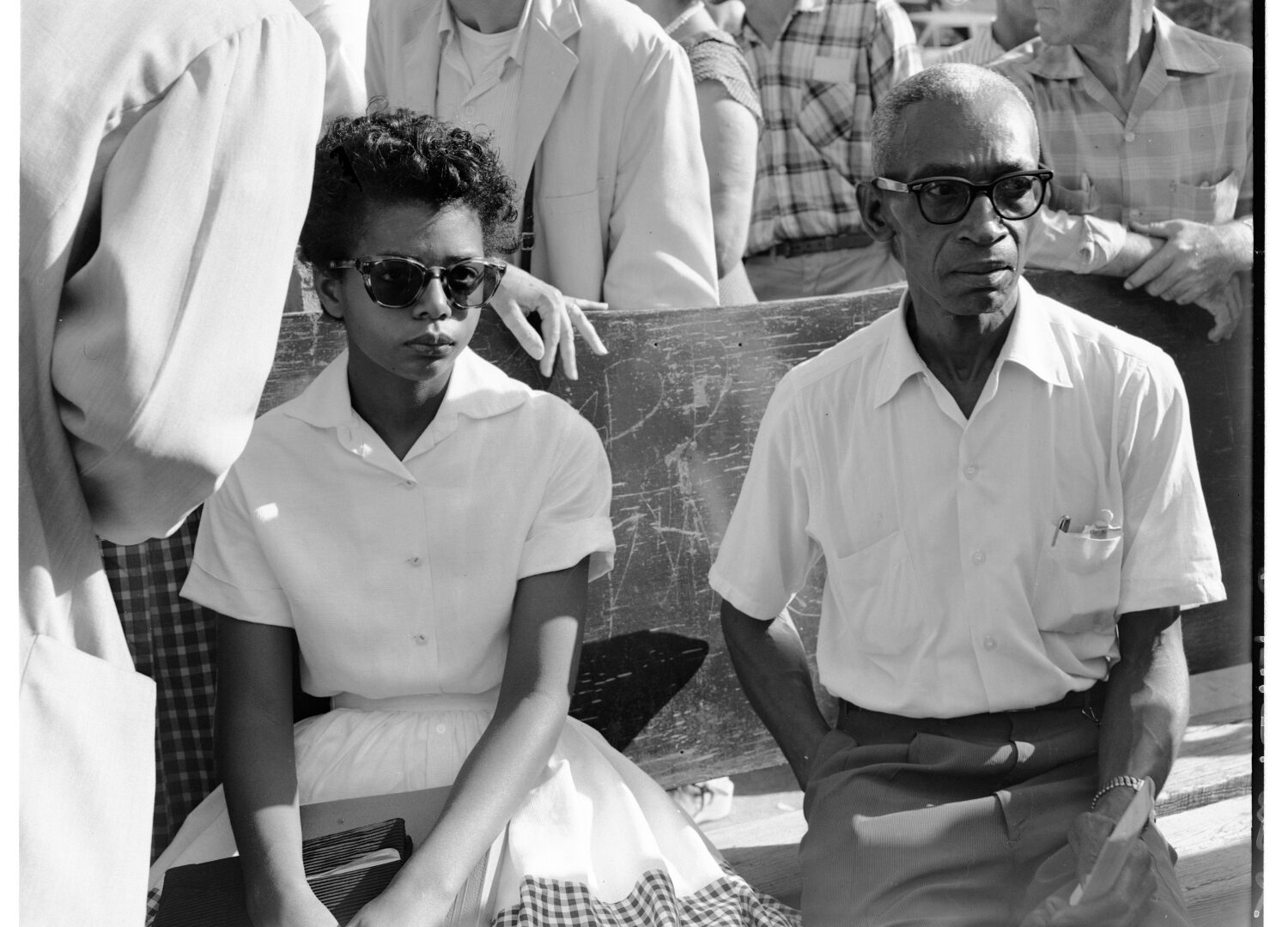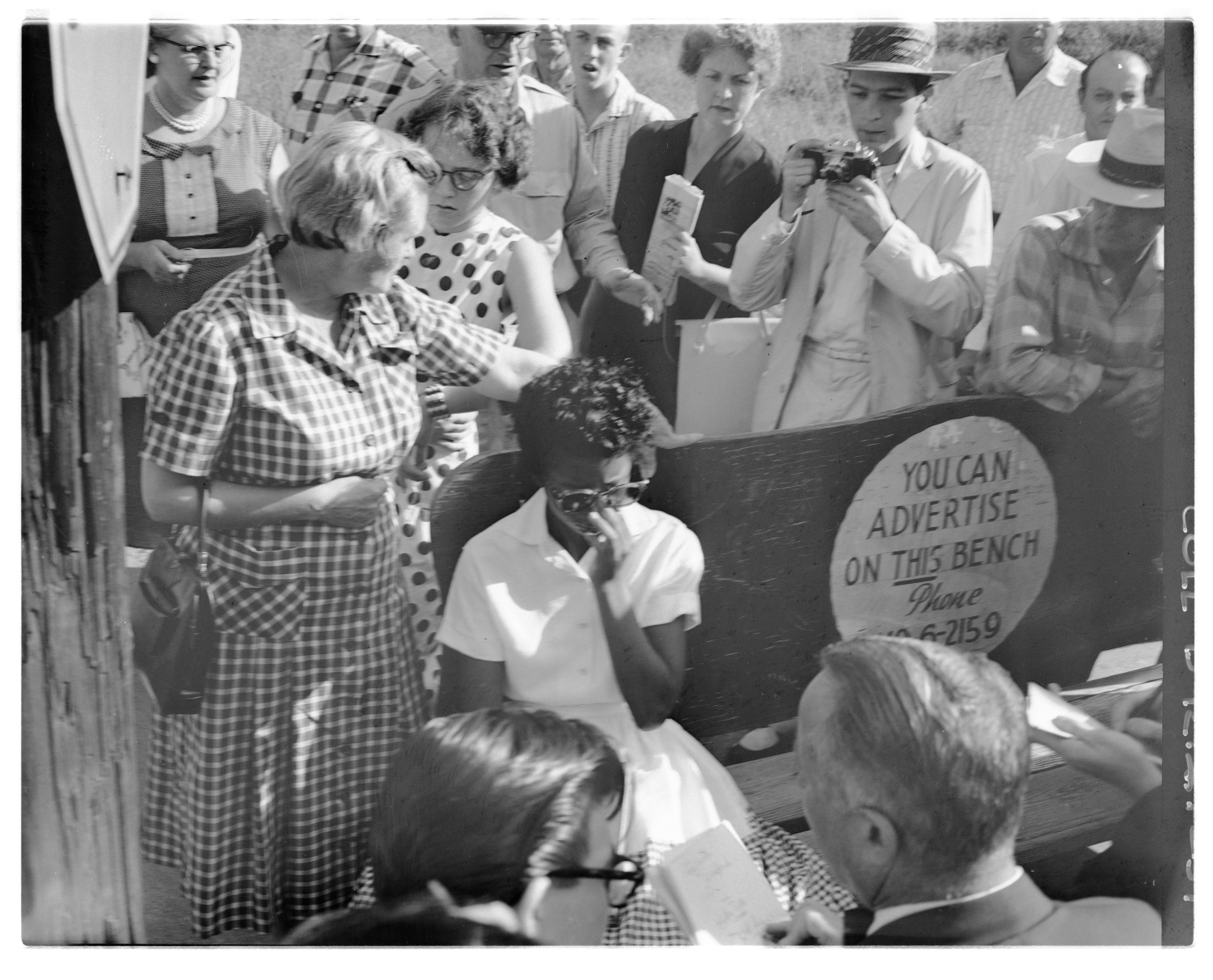Introduction
In 1955, following Brown v. Board of Education, the Little Rock school board accepted a plan of gradual integration presented by superintendent Virgil Blossom. According to the plan, Little Rock schools were to begin integration process in the fall 1957. However, when nine African American students enrolled in previously all white Little Rock Central High School appeared in front of their new school on September 4, 1957, they were met by a white angry mob and the Arkansas National Guard. Governor of Arkansas Orval Faubus called the latter not to protect the black students’ right to equal education but to block them from entering the school building.
On September 4, all black students enrolled in Central High planned to meet near the school at 8:30 AM to walk to the school building together. However, one of them, Elizabeth Eckford, did not receive a message about the plan and arrived alone around 8:00 AM. The National Park Service describes Eckford’s experience from that morning, “Elizabeth rides a bus to Central, approaches the school just before 8:00 a.m. and sees the soldiers of the Arkansas National Guard surrounding the school. Barred by the soldiers in several failed attempts to be allowed past their ranks, Elizabeth finds herself in the throes of an angry mob of protesters numbering over 300+ on Park Street. Chants [“Two, four, six, eight! We don’t want to integrate!”], racial epithets, terroristic threats and spit descend down on this fifteen-year old student as she attempts to make her way to the end of Park Street where perceived safety awaits her at another bus stop. After arriving at the bus stop, Elizabeth waits for 35 minutes.”
Activity Questions
Elizabeth Eckford with Grace Lorch during Little Rock Central High School desegregation crisis
- When and where were the two photos taken? Who are the individuals in the photos? See the short photo descriptions and “Introduction” for more information.
- Examine the two photos. What is happening in each of them? Who are the people surrounding the young woman on the bench? What are they doing?
- How would you describe the young woman on the bench? What emotions can you see in her face and in her body language?
- Compare the two photos. What similarities and differences between them do you see?
- Compare L.C. Bates and Grace Lorch, the two individuals who accompany Eckford. Note that Bates is sitting calmly next to Eckford while Lorch is standing and actively shielding Eckford. How would you interpret this difference in their behavior?
- What do these two photos tell you about the experience of black Americans in Arkansas in the 1950s? What do they tell you about the experience of black youth at the time?
- Elizabeth Eckford was fifteen years old when these two pictures were taken. What does her story tell us about the role of youth in the civil rights movement? What does her story tell us about Arkansas and the United States in the 1950s?
Primary Sources
To learn more about the primary sources featured in the activities above, click the following links:
Arkansas Social Studies Standards
US History Since 1890, Grades 9 – 12
- Strand: Era 9: Post-war United States 1945 to Early 1970s
- Content Standard 5: Students will analyze social, economic, and political changes in the United States between 1945 and 1970.
- Era9.6.USH.1 Analyze the roles of individuals, groups, and the government in securing civil rights during the mid-20th century using a variety of primary and secondary sources (e.g., minorities, women, NAACP, federal court cases, legislation, Twenty-fourth Amendment)
- Era9.6.USH.4 Examine domestic policies of the federal government between 1945 and 1970 and the outcomes from multiple perspectives (e.g., New Frontier, Great Society, civil rights, social issues)
- Era9.6.USH.5 Construct historical arguments of long-term effects of social and economic changes occurring during the mid-20th century using available data and multiple sources
African American History, Grades 9 – 12
- Strand: Illusion of Equality 1950-1970
- Content Standard 6: Students will analyze the African American experience from 1950-1970.
- IE.6.AAH.1 Analyze the various influences of African Americans on political change during the mid-1900s using primary and secondary sources (e.g., feminism, civil rights organizations, political organizations, and labor unions, military)
- IE.6.AAH.2 Examine the various influences of African Americans on social change using primary and secondary sources from multiple perspectives (e.g., migration, feminism, military, social organizations)
- IE.6.AAH.3 Examine various ways African Americans participated in the Civil Rights Movement and the effects of their actions using a variety of primary and secondary sources (e.g., sit-ins, boycotts, marches, speeches, music, methodologies, organizations)
- IE.6.AAH.4 Analyze the effects of legislative developments on the African American experience between 1950-1970 (e.g., voting, civil rights, fair housing, education, employment, affirmative action)
Arkansas History, Grades 7 – 8
- Strand: History Content Standard 7: Students will examine the impact of historical events and people on the development of Arkansas.
- H.7.AH.7-8.8 Analyze social, economic, and political effects of the Civil Rights Movement on various regions in Arkansas from multiple perspectives (e.g., integration, state legislation)
Arkansas History, Grades 9 -12
- Strand: Era 5: World War II Through the Civil Rights Era 1941-1967
- Content Standard 5: Students will analyze factors that influenced the perspectives of Arkansans from World War II through the Civil Rights Era.
-
- Era5.5.AH.9-12.4 Analyze the social, economic, and political effects of the Civil Rights Movement in various regions of Arkansas using primary and secondary sources from multiple perspectives (e.g., segregation; voting; integration of Fayetteville, Hoxie, and Little Rock School Districts; federal and state legislation)
Key Terms
Downloadable Guides and Handouts
We encourage K-12 educators to use History Alive: Virtually! in a way that will best match their classroom needs. The “Exercise” handout includes a complete exercise as featured on this website, the “Primary Sources” handout includes only primary sources used in the exercise, and the “Questions” handout includes analytical questions from the exercise but is editable and can be easily changed to best match students’ needs.
A Young Woman on a Bench – Exercises


